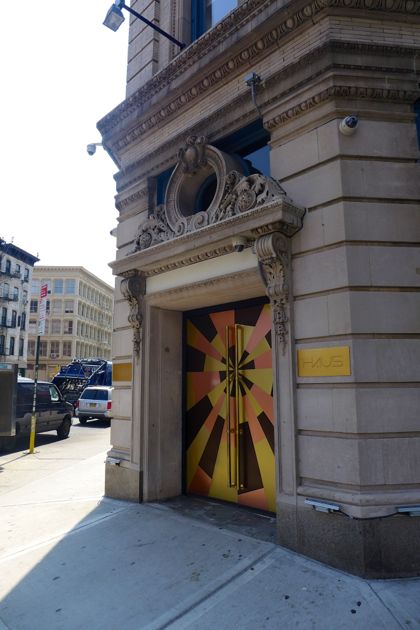Categories
Left column house ads
CB1 Tribeca Committee: The Unofficial Minutes (April)
April 10, 2015 Community News, Events, Restaurant/Bar News
 SIDEWALK CAFÉ WORKING GROUP REPORT
SIDEWALK CAFÉ WORKING GROUP REPORT
The back story behind the working group: The committee used to be able to influence which restaurants had sidewalk cafés (i.e., tables and chairs outside), along with their size, until it became clear about a year ago that the city’s Department of Consumer Affairs was pretty much legally bound to approve anything that was as of right. More recently, the restaurant under construction at 11 Sixth Avenue applied for an enclosed sidewalk café (like the atrium at Super Linda), which CB1 denied—but the city, fearing a lawsuit, went ahead and approved it.
So Community Board 1’s Tribeca Committee created a working group to see if there wasn’t something that could be done to regain its authority. At Wednesday’s meeting of the Tribeca Committee, CB1’s Michael Levine started out by reviewing the findings of the working group: Namely, that of the 51 sidewalk cafés in Community Board 1 (which is all the non-Chinatown parts below Canal, for those of you just joining us), 37 are in Tribeca. (To be fair, there are what look like sidewalk cafés in the Seaport, FiDi, and Battery Park City that aren’t included in the 51 number because they’re not on city sidewalks.) The working group mapped the cafés, and then overlaid the landmark districts (alas, the Landmarks Preservation Commission has minimal criteria for cafés) and the Tribeca Mixed-Use Zoning District. Most of the cafés are, indeed, in the zoning district, and consequently, the City Planning Commission can look into making a zoning change if Community Board 1 requests it. The committee—and eventually the full board—just needed to approve such a resolution. The main reason that the CPC might be open to a change is that the zoning was adopted in the 1980s, and the neighborhood has changed considerably since, shifting from commercial to residential. The resolution simply specifies a general area (Canal to Murray, West to Broadway), and then the CPC would come back to CB1 to work on more specific, street-by-street regulations.
The working group also created new guidelines for café applicants, to be posted on the CB1 website. Most aren’t worth getting into here; of note, however, are the ones that applicants must wait for a year after an initial (non-café) liquor-license application, and that applicants must notify all ground-floor businesses and residential buildings in a 100-foot radius about the application. Currently, the city simply says “within 50 feet.”
There was some discussion about whether enclosed cafés (like Super Linda’s) should be excluded throughout the area, so the language was softened to “selected areas.” And a committee member who is reliably supportive of small businesses wondered whether this wasn’t a solution in search of a problem, noting that CB1 had received minimal complaints about sidewalk cafés over the years, and that applications never face objections; it’s rare that a neighbor even shows up to hear about the details. Another member responded that that could be because until a year ago, CB1 generally denied any cafés on side streets, and until a year ago, the city went along with it.
The resolution passed 8-1.
ANNOUNCEMENT: AMERICAN FLATBREAD MEETING
On April 15 from 6:30 p.m. to 7:30 p.m., American Flatbread will host a meeting with nearby residents and other concerned parties (you’re invited) to discuss its controversial plan to become an event space. There will be snacks. American Flatbread says it will be coming back to CB1 in May to try again.
STREET-ACTIVITY PERMIT: CHURCH STREET SCHOOL
To celebrate its 25th anniversary, Church Street School for Music and Art is bringing its annual party out to Warren Street, taking over Warren from the school west to Greenwich Street, on Sunday, May 17, from 10 a.m. to 5 p.m. (the event is noon to 4 p.m.).
 CABARET LICENSE APPLICATION: HAUS (285 W. BROADWAY)
CABARET LICENSE APPLICATION: HAUS (285 W. BROADWAY)
I figured Haus’s request for a cabaret license (to allow dancing) would be a slam dunk, because the committee has been pretty willing in the past to say yes to the nightclub, despite the proprietors’ track record of not being upfront. But two of the members went after Haus owner Paul Horowitz. One pointed out that Horowitz has been disingenuous from the start, when he swore Haus would be a “mixology lounge” and not a club. “You say one thing and do another, and blame it on someone else,” said the other member. Horowitz claimed that he has said from the get-go that he planned on applying for a cabaret license (although his lawyer told me that would be “in case someone dances.”) He also trotted out the “we don’t have a designated dance floor” line again, but members were less receptive this time, finally acknowledging that the furniture can rather easily be moved out of the way. And Horowitz also said that really only 20 to 30 people were likely to be dancing at a time—which for a club with a capacity of 348 is either unlikely or reflects poorly on the quality of fun being had there. “We’re trying to operate legally,” Horowitz said, as if he was on the high road, explaining that people are going to dance and there’s no stopping them so Haus needs the license or it’ll get fined and possibly shut down.
While there was concern about what would happened if the club got very popular, the bigger issue might be what happens if (I mean when, considering that all nightclubs die eventually) it starts to fail: The proprietors get desperate and bring in less reputable promoters, and next thing you know, you have a Greenhouse situation.
Members worried whether, if they OKed the application, they weren’t essentially encouraging applicants to lie: After all, if Haus had declared itself a club and asked for a cabaret license when it opened last summer, the committee would probably have said no. After an absurd amount of time debating whether the vote would be to approve the application or reject it—it was to approve—the final count was 4-2-1. So it carries, to next go before the full Community Board 1.
3 Comments
Comment:
Subscribe
Subscribe to the TC Newsletter













I do not like Haus for a multitude of reasons:
1. It’s wannabe LA velvet rope pretentious and the ropes look awful when there is literally no one in it save towards the end when people are being checked in. Also where’s the sign? Where’s some identifying mark out front?
2. The women are by and large unfriendly, aloof, wrapped up in their “smart” phones, and overall disconnected – nothing like the club girls of the ’80s and ’90s. They’re not even club girls with their highschool prom/fraterity-sorority party/wedding/some awards event attire. Take that to an outer borough, LI, or NJ. I am not the most handsome guy but I am good looking and I don’t even get a smile back at my smile, or even a nod, when I pass by. I don’t expect every girl or most girls to smile but can one of you crack one? You’re at a house club on a Fri/Sat. night, smile. Most of you look like you’re waiting to go to the bathroom. So uptight and/or stuckup. It really wasn’t like that in the ’80s, ’90s, or even early ’00s for the most part.
3. Most of the women are with someone which is a turnoff cuz why would I go to a club where it’s more like a date club than one where I could meet someone? The number of single women should ALWAYS outnumber the number of taken women. Too many couples.
3. The patrons block the sidewalk along West Broadway and security does nothing about it.
4. It has this “we’re from not around here so fuck this area” vibe to it. Proof is how many Haus people hit Nancy Whiskey Pub or TriBeCa Tavern for a beer before heading home?
5. They won’t have any other events other than house music. Boring, closedminded, and not the way to stay in business for years considering their room holds not even 350 paid people and most house fans want to go to big clubs for the big club with lots of people (and chances to hook up) experience. This place is too small with too few singles and not enough people to get the energy going, so do other stuff. Have live music. Limelight had live music.
6. It just has an overall air of snobishness which is a turn off. It’s more like yet another NYU/hipster watering hole with big beefy bouncers. I mean let’s be honest you had alot of snobs at clubs back in the day – it wasn’t one big love-in – but at least back then you could also meet someone cool more often than not. Now? Where is that someone here? Again it looks like a highschool prom/college hangout. Where are today’s version of the Club Kids? I wasn’t part of or really into that scene but at least they made an effort.
7. I would feel out of place if I showed up dressed like an ’80s or ’90s house club guy considering most of the guys wear t-shirts, polos, and dress shirts with dress pants or jeans. Also there are more men than women a big no no with house/dance clubs that want a straight scene like Haus obviously does.
8. It’s random and not creative and where’s the big name house artist? I’ve yet to see a line around the block for one. I’ve yet to see any kind of line ’round the block event here save maybe the opening.
9. When the club first opened I told the guy who owns the place cool to see a club open in the neighborhood as I walked by and he seemed indifferent. Ok ef you then.
10. I’m not gay but it seems unwelcoming to gay people considering it looks like mostly straight people and straight couples and alot of jock types from listening to them as I pass by and I pass by alot. That’s a death blow to a house club. You need the gay community, too, to be in business. You know Pacha and XL have that.
In short, I think it’s a nightclub which plays house but calls itself a house club when it is not. It doesn’t have the capacity, the patrons, or the vibe. I give it two or three years.
The smartest person in the room “a committee member…wondered whether this wasn’t a solution in search of a problem, noting that CB1 had received minimal complaints about sidewalk cafés over the years, and that applications never face objections”
Completely agree. We don’t need this committee.